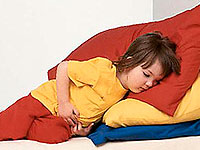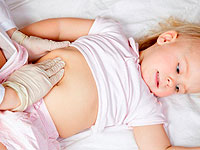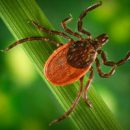Nausea, vomiting, diarrhea, high temperature, abdominal pain - these symptoms most often talk about intestinal infectious diseases. Kids in the risk group. What you need to do so that the child does not get sick?
Content
 Acute intestinal infectious diseases in children are caused by bacteria, viruses and simple microorganisms. From a sick person or an animal in the child's body, they are entered by dirty hands, through household items, toys and nipples. Often the reason for infection becomes unfaithful or incorrectly processed products, drinking water. Sometimes contaminated water kids swallow during swimming in open water and swimming pools.
Acute intestinal infectious diseases in children are caused by bacteria, viruses and simple microorganisms. From a sick person or an animal in the child's body, they are entered by dirty hands, through household items, toys and nipples. Often the reason for infection becomes unfaithful or incorrectly processed products, drinking water. Sometimes contaminated water kids swallow during swimming in open water and swimming pools.
Infectious diseases of the gastrointestinal tract in children proceed quite hard, accompanied by severe intoxication and sometimes lead to complications. Nausea, vomiting, diarrhea, weakness, lack of appetite, abdominal pain — Here is an incomplete list of symptoms of intestinal infections. You can protect yourself from them carefully observing the rules of hygiene and sanitation.
10 «Golden» Rules for the prevention of infectious diseases in children
To prevent the occurrence and distribution of infectious diseases of the gastrointestinal tract in children, the World Health Organization has developed a summary of the Rules of Hygiene and Sanitation.
- Carefully choose food. Do not acquire food products for food in unauthorized trading places or random. Do not buy overdue products in damaged package or stored in improper conditions.
- Let's only safe food food. Use pasteurized or boiled milk, boiled or bottled water. Raw vegetables, fruits, berries Thoroughly wash with boiled water. If you want to extend the shelf life of the food product, expose it to heat treatment or deep freezing, but remember, no one has canceled safe storage time.
- Food of the child should pass full culinary processing. Meat, bird, raw vegetables are amized by pathogenic microorganisms. In the process of heat treatment, upon reaching 70 0Most microbes dies. The use of non-urgent, unfaded products leads to the development of intestinal infectious diseases in children. To ensure deep warm-heartment dishes, frozen foods must be completely dropped before cooking.
 Prepare food for a child immediately before use, Do not store cooked dishes for more than 3 hours. Heat inside the product creates comfortable conditions for breeding pathogenic microorganisms, the risk of intestinal infection increases ten times.
Prepare food for a child immediately before use, Do not store cooked dishes for more than 3 hours. Heat inside the product creates comfortable conditions for breeding pathogenic microorganisms, the risk of intestinal infection increases ten times.- Store food for a child. They must be protected from insects, rodents and animals capable of becoming a source of infection or a carrier of a dangerous infection. Use for storage products tightly closing containers or banks. Make sure that the packaging is thoroughly washed before one or another product will be placed in it. Cooked dishes should be stored either in hot (at temperatures above 60 0C) or cold (at a temperature of 5-7 0C), the rule is extremely important if necessary «Extend life» product up to 3 hours.
- Competently prepare storage products. Food for children is better not to store, but if such a need arose, remember that by placing a large amount of warm products in the refrigerator at the same time, you will not provide fast cooling. Product temperature for a long time will remain elevated (above 10 0C), it means that the threat of microbes reproduction arises.
- Expose heat processing (Temperature above 70 0C) products stored in the refrigerator longer than 3 hours.
- Do not store raw foods along with finished food, Do not mix food residues with freshly prepared dishes. Use for cutting raw and finished products separate cutting boards and knives.
- Often wash your hands thoroughly Before cooking and after each break in the cooking process. In the presence of an infected wound on hands, treat it with an antiseptic and impose a leukoplasty. Keep the kitchen in perfect clean.
- We wash your hands more often, Watch out for the cleanliness of his toys surrounding items, study from the bad habit «pull one's mouth».
Prevention of infectious diseases in children — The right way for parents avoid unrest on the health of the child.









